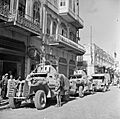Battle of Deir ez-Zor (1941) facts for kids
Quick facts for kids Battle of Deir ez-Zor |
|||||||
|---|---|---|---|---|---|---|---|
| Part of the Syria-Lebanon Campaign of World War II | |||||||
 Map of Syria and Lebanon during World War II |
|||||||
|
|||||||
| Belligerents | |||||||
|
|||||||
| Commanders and leaders | |||||||
The Battle of Deir ez-Zor was an important fight during World War II. It was part of the Syria-Lebanon campaign, where the Allied forces invaded Syria. This battle is famous for the clever plans used by the Allied commander, William "Bill" Slim. He used surprise attacks to get around the enemy, a tactic he would use again later in the war.
Contents
Why the Battle Happened
On June 8, 1941, the Allies began their attack. They moved from Palestine and Transjordan into Lebanon and southern Syria. The main goal was to stop Nazi Germany from using French territory in Syria. This would protect British Egypt, where the Allies were fighting other battles.
By June 20, the Allies had captured Damascus. The Allied commander, Henry Maitland Wilson, then ordered more attacks. These attacks were aimed at Palmyra and Aleppo from western Iraq.
Allied Forces Prepare
A group of Allied soldiers gathered at Haditha. This group included the 21st Indian Infantry Brigade and the 25th Indian Infantry Brigade. These brigades were part of Bill Slim's 10th Indian Infantry Division. They also had the 2/8th Gurkha Rifles.
Their mission was to move along the Euphrates River. They planned to capture several cities: Abu Kamal, Deir ez-Zor, Raqqa, and Meskene. After that, they would advance to Aleppo in the far north-west of Syria.
Deir ez-Zor's Importance
Deir ez-Zor was a very important city in eastern Syria. It had two key bridges that crossed the Euphrates River. Controlling these bridges was vital for moving troops and supplies.
The Battle Begins
The first groups of the 10th Indian Division left Haditha on June 27. They captured Abu Kamal easily, with no fighting. By June 30, the main force was gathered there. On July 1, they started moving towards Deir ez-Zor.
The roads were bad, making progress slow. French planes also attacked them from the air. But by the afternoon, some Allied units were only about 9 miles from Deir ez-Zor.
Slim's Bold Plan
Commander Slim had a daring plan. He wanted to attack the city from the south-east. But he also planned to send a special force on a wide detour. This force would go around the city and attack from the enemy's rear, along the road to Aleppo.
There was a risk: the flanking force might run out of fuel. If that happened, they would be stuck just as they met the enemy. But Slim decided the risk was worth it. He believed this surprise attack would catch the French defenders completely off guard.
The Surprise Attack
On July 3, the 2/10th Gurkha Rifles attacked from the south-west at 9:00 AM. The flanking column had left Mayadin earlier, at 4:15 AM. This column included infantry from the 4/13th Frontier Force Rifles and armored cars from the 13th Duke of Connaught's Own Lancers.
They crossed the Palmyra road about 20 miles from Deir ez-Zor. By 10:30 AM, they reached the Aleppo road behind the city. Slim's plan worked perfectly; the French were totally surprised.
The flanking force quickly moved into the city. They captured the bridges without damage. This made the French defenses facing the Gurkhas from the south-east very weak. By 11:00 AM, these French positions were abandoned. The two Allied attacking forces met up in the city.
By 3:30 PM, all resistance in Deir ez-Zor had stopped. However, French planes continued to attack the Allied ground forces.
What Was Captured
The Allies took about 100 prisoners. Many Syrian soldiers changed into civilian clothes and escaped into the countryside. But the Allies captured 50 trucks, nine guns, and five airplanes. They also found a lot of weapons, ammunition, and fuel.
After the Battle
On July 5, the city of Raqqa was taken without a fight. However, French planes still controlled the skies. They continued to cause casualties, so Allied supply convoys had to travel at night.
Meanwhile, other Allied groups were moving in northern Iraq. The 10th Indian Infantry Division's 20th Indian Infantry Brigade made a fake attack from Mosul. Another group, the 8th Indian Infantry Division's 17th Indian Infantry Brigade, moved into north-east Syria. They captured a long section of railway and large amounts of weapons and ammunition. They did this without any casualties.
The French forces pulled back towards the west, along the Mosul-Aleppo railway. Slim sent some of his Gurkha and Lancer forces north from Raqqa along the Euphrates. They had a small fight at the Euphrates crossing at Jarabulus.
By July 8, the 10th Indian Division was moving towards Aleppo. This threatened the main French forces around Beirut from behind. The French commander, General Dentz, realized his position was hopeless. He asked for a ceasefire. Talks began on July 11, and the ceasefire agreement was signed on July 14.
Images for kids
-
Marmon Herrington armoured cars in Aleppo on 22 July 1941


